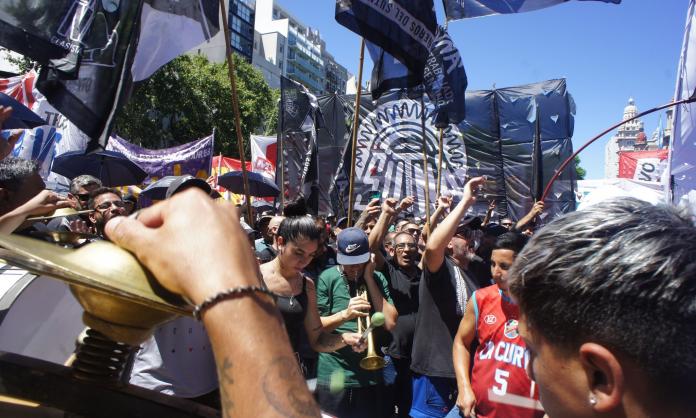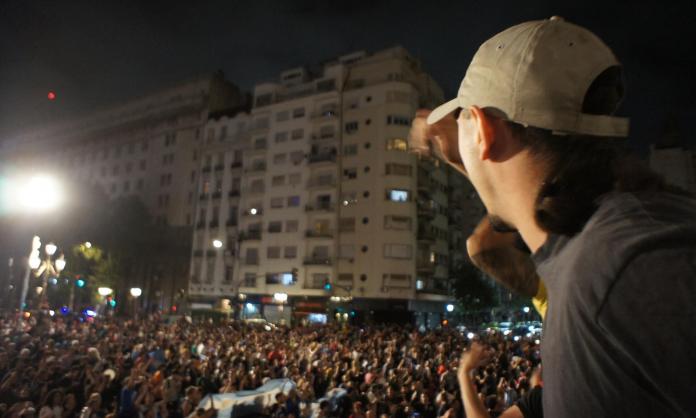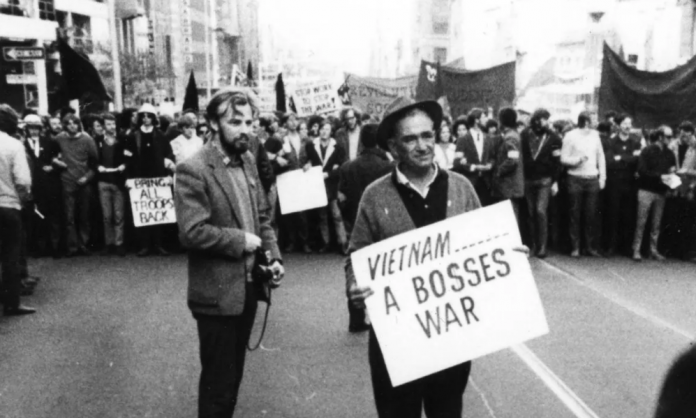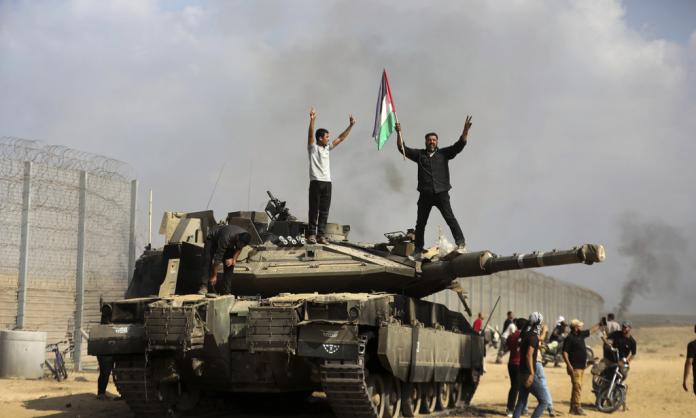A general strike against Argentina’s far-right president, Javier Milei, rocked the country on 24 January, just 45 days into his new government’s term. By mid-morning, the plaza outside the National Congress building in Buenos Aires, the capital, was packed. More than half a million people turned up to protest—striking workers, the unemployed, representatives from neighbourhood assemblies, people mobilised by social justice organisations and left-wing political groups.
Streets leading to the plaza were packed so tight with people that it was hard to move. Cheering and singing tyre factory workers, throwing water across each other, were half drowned out by drumming and chanting from all different directions of the mobilisation. Amid the chanting, smoke rose from barbecues, carrying the smell of choripán (a type of sausage), schnitzel, bacon and eggs. Vendors hawked Coke bottles carried atop platters balanced on their heads; workers crouched to pour maté, a staple Argentinian tea.
The country is in crisis, inflation being in triple figures and the country now the largest debtor to the International Monetary Fund. In late December, Milei announced privatisations, closures of government departments, attacks on workers’ rights and crackdowns on civil liberties. He is supported by the Argentine capitalist class and the country’s creditors.
Previous presidents have attempted to wind back economic, social and democratic rights, but have been stymied by mass opposition. Milei’s attacks are an attempt to settle everything—to do in Argentina what conservative Prime Minister Margaret Thatcher did in Britain in the 1980s: destroy the confidence of the working class and defeat the unions so that the rich can shape the economy and society without opposition.
On the day of the strike, nothing else was news. After the trains carried the stragglers home before grinding to a halt as the drivers finally got to participate in the shutdown, television screens across the country were filled with commentary. Security Minister Patricia Bullrich insisted that the demonstration was small and insignificant. But according to the main trade union federation, the General Confederation of Workers (CGT), more than 1.5 million participated in protests across the country.
The strike was a show of force by the diverse social layers that have entered the struggle against the new president. For example, most of the plaza in Buenos Aires was filled by huge contingents of piqueteros—unemployed and precariously employed people who rely on subsidies, including food and social services, distributed through government schemes known as social plans. It’s possible there were equal numbers of piqueteros and organised workers at the strike demonstration in the capital.
Large parts of the country were paralysed by the strike. The nationalised airline, Aerolineas Argentinas, was forced to cancel more than 300 flights and reschedule another 26. Banks closed their doors from noon. State department workers had a huge presence, and many teachers and health workers joined the strike. Ford, Toyota and Peugeot car factories were shut.
Yet there were limitations. It was a huge show of force, but it was also considerably smaller than what the unions have been capable of mobilising in the past.
The CGT announced the strike a month in advance, and other trade union federations announced that they would join it. But the CGT is highly bureaucratic and run by industrially conservative Peronists. “Peronism” takes its name from Juan Perón, a military officer who governed Argentina several times between 1946 and 1974. Ideologically, Peronism is associated with state intervention into the economy and “national independence”. Politically, it spans the spectrum from the centre right to the centre left. The more left-wing variants add social justice and human rights into the nationalist mix.
When in government, Perón handed big concessions to the workers’ movement while forcibly taking over the unions, killing and kidnapping left-wing rivals. But two Peronist governments were overthrown by right-wing military dictatorships, which has given Peronism a democratic gloss. Photos of Perón’s wife Evita are everywhere in Argentina, especially in the homes of progressive women.
Peronism is comparable to Laborism in Australia in that it maintains a tight hold over the union bureaucracy. But there are important differences. While the Labor Party and the European social democratic parties emerged from, or were part of founding, the workers’ movement, Peronism has always been dominated by members of the ruling class.
The Peronist union bureaucracy didn’t do the detailed organising work necessary to convince large sections of workers to participate in the strike. In many places, the CGT mobilised only union delegates rather than the entire workforce. The bureaucracy is afraid of its own working-class base and doesn’t call demonstrations that might get out of its control. It wanted the demonstration on the day of the strike to be weighted towards workplace delegates, who are more loyal to the leadership.
So while the strike and demonstration were big in absolute terms, in relative terms they were still modest—half a million out of a population of 15.6 million in Buenos Aires, for example.
Argentina has various revolutionary socialist organisations. Their membership numbers are in the thousands, rather than tens or hundreds of thousands, making them substantially weaker than the Peronist machine. But when the groups work together, they have considerable influence and are capable of meaningfully intervening into mass politics. That the general strike was held at all was partially a result of the left’s pressure on the CGT leaders.
The Socialist Workers’ Movement (MST) is a useful case study. The three main projects of its members before the strike were: convincing as many of their workmates as possible to join the strike, leading mass rank-and-file assemblies and protests of arts sector workers and building a coalition of diverse groups to provide ongoing political leadership in the struggle.
Mobilising workers for the strike wasn’t straightforward. More than 50 percent of people, including large numbers of workers, voted for Milei in November. Because most of his attacks haven’t been implemented yet, and because the economic crisis long preceded him, many don’t view the new president as a threat to their wellbeing and haven’t broken from him. In the lead-up to 24 January, union delegates from the left put in long, detailed work to convince their workmates to attend.
“As soon as the strike was announced, we began to hold meetings and tours through the workplace discussing the need to strike”, Cesar Latorre, an MST member and lead delegate at a private hospital, told Red Flag. “In the first weeks, the debates were minor, but as the date approached, the debates became highly politicised.”
Latorre and his delegate team spent hours in each hospital department responding to questions and explaining the purpose of the strike.
“The first difficulty was the refusal of one sector to mobilise and stop work because the strike was being called by the CGT after a long time of the federation doing nothing. Then there were other workers who supported Milei’s government and said we had to let him govern”, Latorre said.
Some sections of workers joined the independent contingents, or “columns”, led by the revolutionary socialist parties around the country. In Buenos Aires, many thousands of people joined the left-wing “multi-sectoral” column organised through meetings and assemblies prior to the strike. It was initiated by Syndicalismo Combativo, a forum of union delegates who are members of socialist organisations. It is normal for that group to march together, but at the general strike they were joined by an unusually large number of others.
Syndicalismo Combativo planning meetings included representatives of social justice organisations, unaligned piqueteros, retirees, neighbourhood assemblies and human rights organisations.
Days before the strike, a prominent rank-and-file group of arts sector workers, in a mass assembly of more than 600, voted to join the left contingent. Members of the MST led the argument in the assembly. This led to other organisations, including a prominent abortion rights group, announcing they would also join the contingent. Tyre workers voted in assemblies to join it, as did a section of railway workers. Around 3,000 people from various neighbourhood committees met early to join the left column, but couldn’t get through the packed crowd to reach it.
Claudio Mora, an MST member delegate in the National Directive Commission of the tyre factory union, explained to Red Flag during the strike:
“The strike was voted on in assemblies in each of the factories. Our strike won’t end at the same time as the CGT’s action—we will stay out until tomorrow at six in the morning. We are in the independent column because there is a need for a continuity of the struggle until we defeat Milei’s plans.
“The tyre union is strong, so we have a safeguard in our contracts to protect us from inflation, which means that we don’t lose as much from our salaries as the other workers. But our fundamental task is to be present and to lead, and try to give confidence to all the other sections of workers. That’s partly in terms of economic outcomes, but also in terms of organisation. We want to help encourage other workers to overcome the situation that they are in today, where the union bureaucrats control their workplaces. Instead, we are encouraging new delegates, new internal commissions, a new body of fighters to emerge, who also dedicate themselves, in addition to the union, to politics.”
A new cycle of struggle has begun in Argentina. On 20-21 December, enormous and spontaneous night-long protests shocked the wealthy. After that, however, there were no mass mobilisations until the left and the unions called demonstrations. But neighbourhood assemblies emerged in scattered suburbs of Buenos Aires and other parts of the country. They were much smaller than during the radicalisation of 2001, but undeniably real. The 24 January general strike was led by the union bureaucracy, but it opened a space for rank-and-file assemblies and for debates in some workplaces, into which the socialist organisations intervened.
Struggles have risen and fallen in the last twenty years all over the world. But without revolutionary parties, even the bravest militants have been confined to a role akin to foam on a raging ocean. In Argentina, the construction of revolutionary socialist organisations is under way. To beat the conservative mass political forces, they will need to grow significantly. But they are of a size that enables them to intervene meaningfully. This makes the situation in Argentina more dynamic and open than in many other parts of the world.











